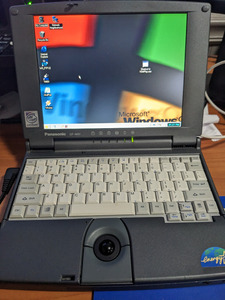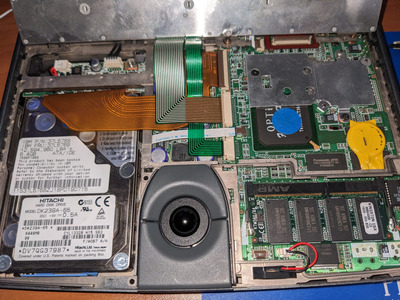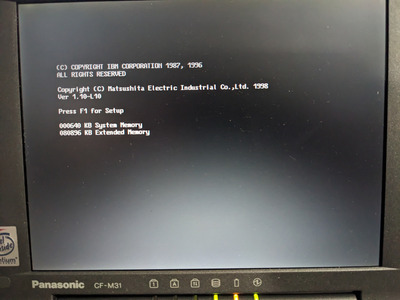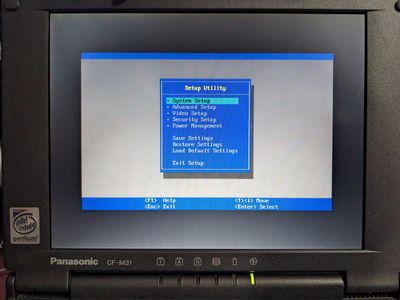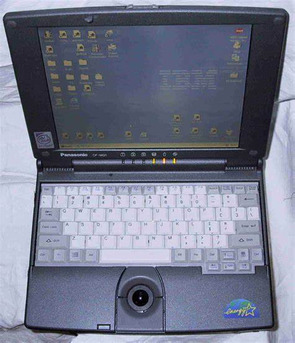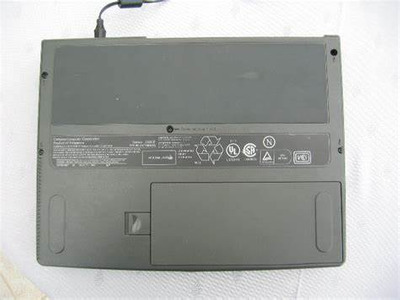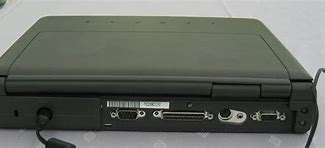First post, by MrKsoft
- Rank
- Member
Posting up a thread in an attempt to get more information on this system. I originally picked it up a few years ago, and as time as gone on I have found that there is basically nothing regarding this laptop out there.
This is a subnotebook, similar to the Toshiba Librettos. It is a little bit bigger, more of a standard laptop form factor, and has a trackball! The hardware is nothing special, but it is reasonable for DOS gaming. Windows gaming a less so, as this doesn't have 3D acceleration or anything, but it can still run anything from Win3.x up for productivity use. The keyboard's a little small, but that comes with the territory. The trackball is wonderfully smooth, but again it is also a little small. One benefit from a DOS gaming perspective is that the volume and brightness controls (on the Fn-keys) are BIOS controlled and will work even in pure DOS. While I'd prefer hardware knobs, this is still better than some other laptops of the era.
- CPU: Pentium MMX 120mhz - no L2 cache, so a bit slow
- Chipset: OPTi 82C701 "FireStar+"
- RAM: 16MB EDO onboard, added 64MB for a max of 80MB
- Graphics: NeoMagic MagicGraph 128ZV (NM2093)
- Screen: 8.4" 800x600 TFT - which is a bit let down by the NeoMagic chip's absolutely dreadful LCD scaling
- Audio: Yamaha OPL3-SA3 (YMF715)
- I/O: 2x Cardbus slots (using a Ricoh RL5C476 controller) IrDA, and headphone/mic, everything other than that needs the port replicator (CF-VEBM31) which adds an external floppy drive (CF-VFDU01), PS/2 port, VGA, serial, and parallel
- Storage: Currently using a 6.4GB Hitachi drive out of an old Thinkpad.
- Battery: long dead, but apparently lasted 2.5ish hours
It appears to have been introduced around July 1998 according to a single article I dug up. But the real mystery is the fact that, apart from that article, this model seems to have been completely erased from Panasonic history. I suspect this is due to two things: It appears to have been very quickly replaced by a faster (MMX166 with cache), and internally quite different CF-M32. There's also the fact that there is a much later, similarly named "CF-31" which is completely unrelated. Checking Panasonic's FTP, it has drivers for the CF-M32 but the CF-M31 folder is straight up empty. I dug through the Wayback Machine and it is never even listed on any of their pages as far as I can tell. The CF-M32 shows up a bit later, but the CF-M31 is not acknowledged. I wonder what the story is? Was it just replaced that quickly, or was the M31 a limited release perhaps?
Now there is one cousin of the CF-M31 that does appear to be more well known - the Let's Note AL-N4. I actually heard about this when I originally posted here that I had acquired this laptop. The AL-N4 is almost certainly the Japanese equivalent model - all the info I can find matches. But for whatever reason the CF-M31 remains invisible. Either way, neither of them have too many resources out there such as official drivers or BIOS updates.
I am kind of hoping that by posting this we can scare out of additional info or at least some idea of what the latest BIOS is for this. The BIOS appears to be based on an IBM BIOS for some reason? It doesn't have a lot of options, and the specific version I have on here (1.10-L10) has some quirks...
- Hard drive detection is incredibly finicky. It had a pretty small drive installed initially so of course I put something else in, but I found that it was very arbitrary as to what drives will and will not accept. The problem being, if it doesn't "like" a drive, it just hangs after the RAM check and never POSTs, so I can't for instance use a drive overlay to get large disk support. Anything above 8GB doesn't work, not really a surprise there, but other smaller drives will not work either, with no apparent rhyme or reason. For instance, a 6.4GB drive might work, but a 4.85GB or 3.2GB drive might not. In addition, not a single CF card in an adapter worked, whether it be a consumer or industrial card. With an SD to IDE adapter, most cards did not work, even ones as small as 2GB - but a single 4GB card I had worked-- with some caveats. Namely, if you rebooted the system, it would not detect the drive again until you completely turned it off and back on - so not really ideal.
- Periodically I've run into issues with the resource assignments getting mixed up, especially with the CardBus slots. Like sometimes Windows won't pick them up and I have to go into the BIOS and change the slots to "PCIC compatible mode" and back to "CardBus mode" to get them to wake up.
- System does not seem to react properly to APM power off. If you shut down in Win9x the screen will blank after the "Safe to shut down" screen but the system is still running. At this point, it also will not respond to the power switch so the only option is to unplug it. If I exit to DOS instead and use the power switch, it turns off properly. Possibly some kind of lost driver is needed for this to work properly? I do remember it working fine when I briefly ran a Win2K/DOS dual boot on here (can't recommend - it's slow).
Is version "1.10-L10" the last BIOS? How does that compare to the AL-N4's "1.00-L20" which is the only version I have found? Are they possibly cross compatible, i.e. if we can find a way to trick it into flashing an AL-N4 BIOS if that turns out to be newer?
I feel like this is a nice enough system but the BIOS needed a few more revisions to work out the bugs. A later BIOS might work better and possibly be more accepting of random drives...
That's all I've got, but if anyone else knows anything or has resources for this system, post it!
The OPL Archive - Preserving MS-DOS music in a unified format!
